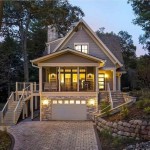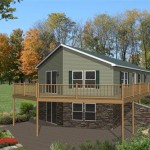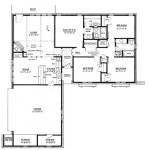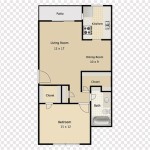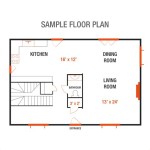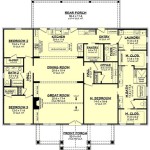1 Story House Plans With Open Floor Plans: A Comprehensive Overview
Single-story house plans featuring open floor plans are increasingly popular due to their accessibility, enhanced flow, and potential for maximizing space. This design approach prioritizes interconnectedness between living areas, such as the kitchen, living room, and dining room, creating a larger, more unified space. This configuration offers numerous benefits and considerations that prospective homeowners should understand before embarking on a building project.
An open floor plan minimizes the use of walls, which traditionally delineate separate rooms. Instead, strategic furniture placement, changes in flooring materials, and subtle architectural details may be employed to define different zones within the larger space. This design philosophy caters to modern lifestyles that often emphasize casual entertaining and family interaction.
The appeal of single-story homes, particularly those with open floor plans, extends across various demographics. They are favored by families with young children, offering easy supervision and eliminating the safety concerns associated with stairs. Conversely, they also appeal to aging individuals and those with mobility limitations, providing accessibility and convenience. The absence of stairs facilitates aging in place, allowing residents to remain in their homes comfortably as their needs evolve.
Key Advantages of Single-Story Open Floor Plans
Open floor plans in single-story homes promote a multitude of advantages, impacting both the aesthetic and practical aspects of daily living. These advantages range from increased natural light to enhanced social interaction, contributing to a more comfortable and functional living environment.
Enhanced Natural Light and Ventilation: One of the most significant benefits of an open floor plan is the increased availability of natural light. With fewer walls obstructing the flow, sunlight can penetrate deeper into the home, creating a brighter and more cheerful atmosphere. Strategic window placement, combined with the open layout, can also improve natural ventilation, reducing reliance on artificial lighting and air conditioning, ultimately leading to energy savings. The cross-ventilation effect can significantly improve air quality and comfort, especially in climates with moderate temperatures.
Improved Social Interaction and Family Connectivity: Open floor plans naturally foster social interaction and family connectivity. The absence of walls allows for seamless communication between individuals in different zones. For example, someone preparing a meal in the kitchen can easily converse with family members relaxing in the living room. This promotes a sense of togetherness and allows for more effortless participation in shared activities. Parents can supervise children playing while simultaneously undertaking household tasks.
Increased Perceived Space and Flexibility: Open floor plans create an illusion of greater space, making even smaller homes feel larger and more accommodating. This is particularly beneficial in single-story homes where the footprint may be limited. The flexibility of an open floor plan also allows homeowners to adapt the space to their evolving needs. Furniture arrangements can be easily modified to accommodate different activities, such as hosting large gatherings or creating dedicated workspaces.
Enhanced Accessibility and Aging in Place: Single-story homes, coupled with open floor plans, offer exceptional accessibility for individuals with mobility challenges. The absence of stairs eliminates a significant barrier, and the open layout provides ample room for maneuvering wheelchairs or walkers. This design promotes aging in place, allowing residents to remain comfortably and independently in their homes as they grow older. Wider doorways and hallways can further enhance accessibility.
Design Considerations for Single-Story Open Floor Plans
While open floor plans offer numerous advantages, it is crucial to carefully consider several design factors to ensure a functional and aesthetically pleasing outcome. Proper planning and attention to detail are essential to maximize the benefits of this architectural style.
Zoning and Functionality: Although open by design, defining distinct zones within the open space is critical for functionality and visual appeal. This can be achieved through various methods, including strategic furniture placement, changes in flooring materials, area rugs, and subtle architectural details like partial walls or columns. Each zone should have a clear purpose and be designed to support specific activities. For instance, the kitchen area may be defined by an island, the dining area by a large rug, and the living area by a comfortable seating arrangement.
Acoustics and Noise Control: The open nature of these plans can sometimes lead to noise issues. Sound can travel freely throughout the space, potentially disrupting activities and creating a less-than-peaceful environment. Implementing sound-absorbing materials, such as rugs, upholstered furniture, and acoustic panels, can help mitigate noise levels. Strategic placement of these materials can significantly improve the acoustic comfort of the home. High ceilings can also exacerbate noise issues, so careful consideration of ceiling height is important.
Storage and Organization: With fewer walls to accommodate built-in storage, it is essential to plan for adequate storage solutions within the open area. Creative storage solutions, such as built-in shelves, hidden compartments, and multi-functional furniture, can help maintain a clutter-free and organized living space. Utilizing vertical space and incorporating storage into furniture design are effective strategies for maximizing storage capacity. A well-organized home contributes to a sense of calm and order.
HVAC and Climate Control: Heating and cooling an open floor plan can present challenges. The lack of walls allows for greater air circulation, which can lead to temperature imbalances. A well-designed HVAC system, potentially incorporating zoning controls, is essential for maintaining consistent and comfortable temperatures throughout the entire area. Consider energy-efficient windows and insulation to minimize energy loss and reduce heating and cooling costs. Ceiling fans can also help circulate air and improve comfort.
Cost Implications of Single-Story Open Floor Plans
The cost of constructing a single-story home with an open floor plan can vary depending on several factors, including the size of the home, the materials used, and the complexity of the design. While the absence of stairs can potentially reduce construction costs, other factors can influence the overall budget.
Foundation Costs: Single-story homes typically require a larger foundation than multi-story homes of the same square footage. This is because the entire weight of the structure is distributed across a larger area. Foundation costs can also be affected by soil conditions and the complexity of the foundation design.
Roofing Costs: Similar to the foundation, single-story homes also require a larger roof area than multi-story homes of comparable size. Roofing materials and labor costs can significantly impact the overall budget. Selecting durable and energy-efficient roofing materials can help reduce long-term maintenance costs.
Framing and Interior Costs: The open floor plan can potentially reduce framing costs due to the elimination of some interior walls. However, this may be offset by the need for additional structural support to compensate for the removal of load-bearing walls. The cost of interior finishes, such as flooring, paint, and cabinetry, will largely depend on the homeowner's preferences and budget.
HVAC and Plumbing: The HVAC system for an open floor plan may require careful design and potentially zoning controls to ensure efficient heating and cooling. Plumbing costs will depend on the layout of the bathrooms and kitchen and the materials used. Consider the placement of plumbing fixtures to minimize pipe runs and reduce installation costs.
In conclusion, opting for a single-story house plan with an open floor plan presents a compelling option for homeowners seeking accessibility, enhanced social interaction, and a flexible living space. However, careful planning and consideration of design elements, acoustic properties, storage solutions, and potential cost implications are paramount to achieving a successful and fulfilling living environment.

Stylish One Story House Plans Blog Eplans Com

One Story Modern Farmhouse Plan With Open Concept Living 1706 Sq Ft 51829hz Architectural Designs House Plans

One Story Hill Country Home Plan With Open Floor And Game Room

Simple House Plans 1 2 Story Modern Floor America S Best Blog

One Story House Plan Examples

Hudson House Plan Sater Design Collection

One Story House Plans Single Floor Design

Plan 44204 1 Story Modern Farmhouse With Open Floor A

One Story Floor Plans Open Concept 4 Bedroom 3 Bath Bedrooms Baths Breathtaking Single Modern Style House

1 Story Craftsman House Plan Foxborough

